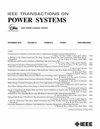基于电气距离的故障定位连续特征表示,用于广义数据驱动的动态安全评估
IF 7.2
1区 工程技术
Q1 ENGINEERING, ELECTRICAL & ELECTRONIC
引用次数: 0
摘要
电力系统的故障前动态安全评估需要考虑不同的故障位置。现有的数据驱动DSA方法缺乏可泛化的故障定位特征,无法准确评估未学习到的故障位置,即不在训练集中的故障位置。针对这一问题,本文提出了一种基于电距离的故障定位连续特征表示方法,旨在构建一种可推广到非学习故障定位的故障前DSA模型。首先,将故障定位连续表示为与预选参考节点的电距离的电坐标。然后,通过参考节点选择和度量学习优化电坐标对故障位置的表示能力;最后,以电气坐标和稳态特征为输入,构建了由卷积和径向基函数网络组成的混合DSA模型,用于评估不同故障位置下系统的角动态和电压动态。在新英格兰39总线系统和中国一个省级系统上验证了该方法在非学习故障定位上的泛化性能。本文章由计算机程序翻译,如有差异,请以英文原文为准。
Continuous Feature Representation of Fault Location Based on Electrical Distance for Generalizable Data-Driven Dynamic Security Assessment
Pre-fault dynamic security assessment (DSA) of power systems needs to consider different fault locations. Existing data-driven DSA methods lack generalizable fault location features, failing to accurately assess unlearned fault locations, i.e., fault locations not in the training set. To address this issue, this paper proposes a continuous feature representation method of fault location based on electrical distance, aiming to construct a pre-fault DSA model generalizable to unlearned fault locations. Firstly, fault location is represented continuously as an electrical coordinate with the electrical distance to preselected reference nodes. Then, the representation ability of electrical coordinates to fault locations is optimized by reference node selection and metric learning. Finally, with electrical coordinates and steady-state features as input, a hybrid DSA model composed of convolutional and radial basis function networks is constructed to assess system angular and voltage dynamics with different fault locations. The generalization performance of the proposed DSA method on unlearned fault locations is verified on New England 39-bus system and a provincial system of China.
求助全文
通过发布文献求助,成功后即可免费获取论文全文。
去求助
来源期刊

IEEE Transactions on Power Systems
工程技术-工程:电子与电气
CiteScore
15.80
自引率
7.60%
发文量
696
审稿时长
3 months
期刊介绍:
The scope of IEEE Transactions on Power Systems covers the education, analysis, operation, planning, and economics of electric generation, transmission, and distribution systems for general industrial, commercial, public, and domestic consumption, including the interaction with multi-energy carriers. The focus of this transactions is the power system from a systems viewpoint instead of components of the system. It has five (5) key areas within its scope with several technical topics within each area. These areas are: (1) Power Engineering Education, (2) Power System Analysis, Computing, and Economics, (3) Power System Dynamic Performance, (4) Power System Operations, and (5) Power System Planning and Implementation.
 求助内容:
求助内容: 应助结果提醒方式:
应助结果提醒方式:


